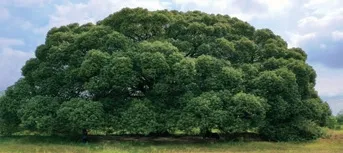Fantastic Camphor Trees
2022-12-06ByMohammadSaiyedulIslam
By Mohammad Saiyedul Islam

A camphor tree in a field in Jiangxi Province
Jiangxi Province, located in the eastern region of China, belongs to the subtropical humid monsoon climate zone with a mild climate, abundant rainfall,and four distinct seasons. It ascends from the banks of the Yangtze River in the north into hillier areas in the south and east. The average annual temperature is 16.3-19.5 degrees Celsius, the annual precipitation is 1,341-1,943 mm, the sun shines here for 1,600-2,100 hours each year and the annual frost-free period is 240-307 days.
Owing to the favorable environment,the local traditions of planting, loving and protecting camphors, and the longevity of the trees, many of the still-remaining camphor forests in the province are thousands of years old. With the 63.1-percent forest coverage, Jiangxi is known as one of the greenest provinces in China.
There is a saying in Jiangxi that there are no villages without camphor trees and there could be no villages without camphor trees. In fact, camphor trees are intimately tied to the history of Jiangxi.Due to its vitality, the camphor tree has long been a symbol of good luck, longevity, happiness and harmony and, in the 1980s, it became the provincial tree of Jiangxi. No part of the tree goes to waste.The branches, leaves, seeds and wood of the camphor all carry its unique scent.
Anfu County is known as the Blessed Land in central Jiangxi. It’s located in the middle of the Luoxiao Mountains,surrounded by mountains on three sides.Like the rest of the province, the county provides ideal conditions for the growth of evergreen trees such as camphors. Due to the large number, wide distribution and old age of Anfu’s camphor trees, it was named by the Chinese Society of Forestry as the Hometown of Camphor Trees in China.
There are more than 120,000 camphor trees in the county, more than 10,000 of which are more than 400 years old. Two hundred of these are known to be more than 1,000 years old.
Many ancient camphor trees are scattered throughout the ancient villages of Anfu, increasingly valued for their unique ecological, scientific research, cultural, and tourism values. Each tree is its own scene and each ancient camphor has a story.Local people often use anthropomorphic techniques to name camphor trees according to their characteristics and appearance.In the eyes of Anfu people, building roads,building bridges and planting camphor trees are the three major acts of kindness one can perform.
The Five-Claw Camphor is an ancient camphor tree that has been growing since the Han Dynasty (202 B.C.-A.D. 220) and that is now a symbol of Anfu. At more than 2,000 years old, it is the oldest camphor tree in Jiangxi. Dubbed the Jiangxi Camphor Tree King in 2019, the tree’s height is 35 meters, the circumference of its trunk is 13.9 meters and the area of the crown is about 2,400 square meters. The tree begins to branch about 5 meters from the ground and its five main branches are said to be like the five claws of a dragon.Although its trunk is now hollow, it is still sturdy and lush with a classic umbrella canopy of leaves.
Camphor trees not only have ornamental value but also have extremely high medicinal and economic value, with all parts of the tree being effective in treating ailments.
The Jiangxi Provincial Government has taken three main steps looking after the province’s many camphor trees. First of all, all the ancient and famous trees in the province have been listed for protection.Second, authorities have taken a “one tree,one policy” approach to protecting ancient or culturally significant trees and rescuing trees threatened by damage, disease or development. Third, they have identified countries excelling in tree protection and carried out tree protection pilot projects,including tree adoption projects.
Ancestors of those who now call Anfu’s villages home have adhered to ages-old rules of planting more and felling fewer. In doing so, they have left behind not only an abundant resource for health and wealth, but also a natural and cultural legacy that still unites the place and its people. BR
